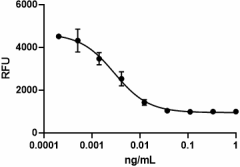- Regulatory Status
- RUO
- Other Names
- Tumor necrosis factor-ž€, Cachectin, Necrosin, Macrophage cytotoxic factor (MCF), Differentiation inducing factor (DIF), TNF superfamily, member 2, (TNFSF2)

-

The ED50 is 2-12 pg/mL, corresponding to a specific activity of 0.83-5 × 108 units/mg, as determined by a dose dependent cytotoxicity assay using L929 cells treated with actinomycin D.
| Cat # | Size | Price | Quantity Check Availability | ||
|---|---|---|---|---|---|
| 580102 | 10 µg | $176.00 | |||
| 580104 | 25 µg | $347.00 | |||
| 580106 | 100 µg | $879.00 | |||
Select size of product is eligible for a 40% discount! Promotion valid until December 31, 2024. Exclusions apply. To view full promotion terms and conditions or to contact your local BioLegend representative to receive a quote, visit our webpage.
TNF-α was originally described as an endotoxin-induced, macrophage-derived factor that promotes hemorrhagic necrosis of solid tumors and the cachexia of chronic infections. TNF-α has also been implicated in a range of inflammatory, infectious, and malignant disorders. At the cellular level, TNF-α modulates a broad spectrum of responses including inflammation, immunoregulation, proliferation, apoptosis, and antiviral activity. In bone, the cytokine inhibits extracellular matrix deposition, stimulates matrix metalloprotease synthesis, and enhances production of osteoclastogenic cytokines such as M-CSF and RANKL. Chronic exposure to TNFa in vivo increases osteoclastogenesis through two distinct mechanisms. TNFa first affects osteoclastogenesis at the osteoclast precursor stage in the bone marrow by priming these cells to differentiate into cFms+/CD11b+/RANK+/- osteoclast progenitors via a RANKL/RANK independent mechanism. These osteoclast precursors then enter the blood and peripheral tissues where they differentiate into mature osteoclasts in the presence of RANKL, and this process is accelerated by TNF. The role of TNF at this later stage of osteoclast differentiation is RANKL/RANK dependent. Importantly, TNF-α promotes bone resorption both in vitro and in vivo by enhancing the proliferation and differentiation of osteoclast precursors.
Product Details
- Source
- Rat TNF-α, amino acids Leu80-Leu235 (Accession # NM_012675) was expressed in E. coli.
- Molecular Mass
- The 157 amino acid N-terminal methionylated recombinant protein has a predicted molecular mass of approximately 17,361 Da. The DTT-reduced protein migrates at approximately 17kDa and the non-reduced protein migrates at approximately 16kDa by SDS-PAGE.
- Purity
- Purity is >98%, as determined by Coomassie stained SDS-PAGE.
- Formulation
- 0.22µm filtered protein solution is in 10mM NaH2PO4, 150mM NaCl, pH 7.2.
- Endotoxin Level
- Endotoxin level is <0.1 EU/µg (<0.01 ng/µg) protein as determined by the LAL method.
- Concentration
- 10 and 25 µg sizes are bottled at 200 µg/mL. 100 µg size and larger sizes are lot-specific and bottled at the concentration indicated on the vial. To obtain lot-specific concentration and expiration, please enter the lot number in our Certificate of Analysis online tool.
- Storage & Handling
- Unopened vial can be stored between 2°C and 8°C for up to 2 weeks, at -20°C for up to six months, or at -70°C or colder until the expiration date. For maximum results, quick spin vial prior to opening. The protein can be aliquoted and stored at -20°C or colder. Stock solutions can also be prepared at 50 - 100 µg/mL in appropriate sterile buffer, carrier protein such as 0.2 - 1% BSA or HSA can be added when preparing the stock solution. Aliquots can be stored between 2°C and 8°C for up to one week and stored at -20°C or colder for up to 3 months. Avoid repeated freeze/thaw cycles.
- Activity
- The ED50 is 2-12 pg/mL, corresponding to a specific activity of 0.83-5 × 108 units/mg, as determined by a dose dependent cytotoxicity assay using L929 cells treated with actinomycin D.
- Application
-
Bioassay
- Application Notes
-
BioLegend carrier-free recombinant proteins provided in liquid format are shipped on blue-ice. Our comparison testing data indicates that when handled and stored as recommended, the liquid format has equal or better stability and shelf-life compared to commercially available lyophilized proteins after reconstitution. Our liquid proteins are verified in-house to maintain activity after shipping on blue ice and are backed by our 100% satisfaction guarantee. If you have any concerns, contact us at tech@biolegend.com.
- Product Citations
-
Antigen Details
- Structure
- TNF superfamily; dimmer/trimmer
- Distribution
-
It is produced primarily by macrophages, and it is also be expressed by activated T cells, B cells, NK cells, and neutrophils.
- Function
- Type II integral membrane protein processed by TACE for secretion; upregulated by interferons, IL-2, GM-CSF, substance P, bradykinin, PAF, immune complexes, cyclooxygenase; downregulated by IL-6, TGF-β, vitamin D3, prostaglandin E2, PAF antagonists
- Interaction
- Monocytes, neutrophils, macrophages, T cells, fibroblasts, endothelial cells, osteoclasts, adipocytes, astroglia, microglia
- Ligand/Receptor
- TNFRSF1A (TNF-R1, CD120a, TNFR-p60 Type β, p55); TNFRSF1B (TNF-R2, CD120b, TNFR-p80 Type A, p75)
- Bioactivity
- Paracrine/endocrine mediator of inflammatory and immune functions; selectively cytotoxic for transformed cells; endothelial cell alterations; chemoattractant
- Biology Area
- Cell Biology, Immunology, Innate Immunity, Neuroinflammation, Neuroscience
- Molecular Family
- Cytokines/Chemokines
- Antigen References
-
1. Boyce BF, et al. J Med 54:127-131 2005.
2. Lam J, et al. J Clin Invest 106:1481-1488 2000.
3. Udagawa N, et al. Arthritis Res4:281-289 2002.
4. Kwon J, et al. Gene 132:227-236 1993. - Gene ID
- 24835 View all products for this Gene ID
- UniProt
- View information about TNF-alpha on UniProt.org
